How Is the Birth of Venus a Good Representation of Renaissance Art
Lasting for over three centuries, the Renaissance proved to be one of the almost popular fine art movements to come from Europe. Seen as a revival of classical learning and wisdom, many artists created paintings and sculptures in the typical Renaissance style. This has led to countless artworks from this era beingness studied through fine art history, as Renaissance works have proved to exist incredibly influential. Some of the most famous paintings to ever be made accept come from the Renaissance period, demonstrating the movement'south unending significance.
Table of Contents
- 1 What Did the Renaissance Art Motion Stand For?
- two The 15 Most Famous Renaissance Paintings to Exist
- 2.1 The Kiss of Judas (1306) past Giotto
- 2.2 Annunciation (c. 1472 – 1475) by Leonardo da Vinci
- 2.3 Lamentation of Christ (c. 1475 – 1501) by Andrea Mantegna
- 2.iv La Primavera (1477 – 1482) by Sandro Botticelli
- 2.five Adoration of the Magi (1481) by Leonardo da Vinci
- ii.half-dozen The Birth of Venus (1485 – 1486) by Sandro Botticelli
- ii.7 The Garden of Earthly Delights (c. 1490 – 1510) by Hieronymus Bosch
- 2.8 The Final Supper (1495 – 1498) past Leonardo da Vinci
- 2.9 The Mona Lisa (c. 1503 – 1506) past Leonardo da Vinci
- ii.x The School of Athens (1509 – 1511) by Raphael
- 2.xi The Creation of Adam (1512) by Michelangelo
- 2.12 The Sistine Madonna (1513 – 1514) past Raphael
- 2.thirteen Assumption of the Virgin (1516 – 1518) past Titian
- 2.14 Venus of Urbino (1534) by Titian
- 2.15 The Last Judgement (1536 – 1541) by Michelangelo
What Did the Renaissance Art Movement Stand up For?
Between the fourteenthursday century and the 17th century, the Renaissance movement dominated the European art scene, with this style going on to affect many areas of society. A variety of aspects in addition to art, such as faith, literature, and politics, demonstrated a noticeable change during the Renaissance, which proved the motion's importance. Increased awareness of nature had occurred due to the resurgence of Greek and Roman art techniques, which saw many artists going on to create truly glorious sculptures and paintings.
Starting every bit a cultural movement in Italia, the Renaissance quickly extended to the greater parts of Europe.
As the Renaissance motion spanned around 300 years, the blazon of paintings that were created signified a period of revolution in art that has however to been equaled. Many of these artworks are withal admired today, with several famous Renaissance paintings being thought to stand for the elevation of what traditional art stands for. Renaissance art has proven its ability to stand up the harsh test of time, which has farther indicated its longevity.
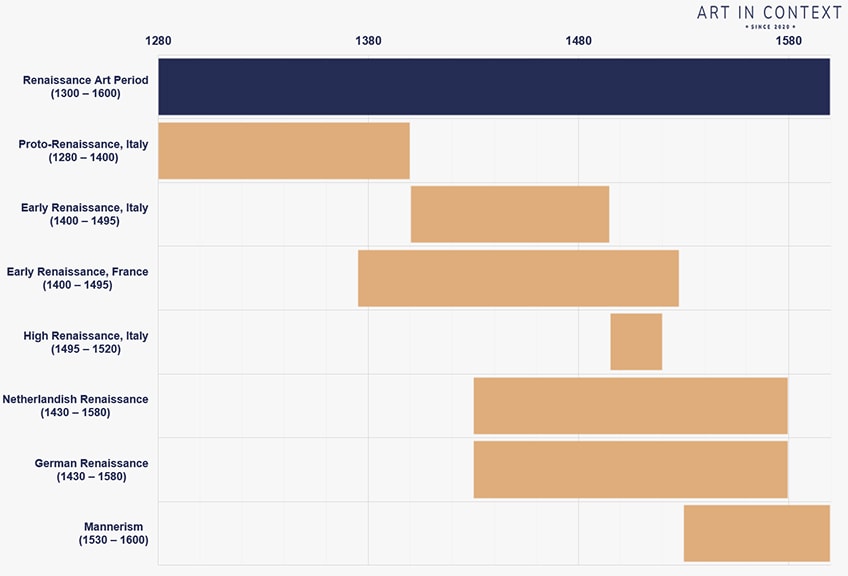
As numerous works were commissioned by the Catholic church, many of the most iconic Renaissance paintings were found in the course of frescoes. This was because the land was considered to be the center of the Cosmic church at the time, with the fresco paintings on the ceilings meaning to describe the gaze of audiences upwards into the heavens. Well-nigh of these famous Renaissance artworks are still in good status and beautify the interior of Italia'due south finest churches and cathedrals today.
The Renaissance played a crucial role in guiding Europe out of its Night Ages and into a mod era of enlightenment.
This aureate age saw the concept of painting take a smashing leap forward in terms of its materials and techniques, with exact anatomical depictions of the human form and linear perspective emerging equally the main focal points. The philosophy of Humanism arose, which compelled artists to wait to the techniques of antiquity. This allowed them to honestly represent the universal homo and his place in the world in their artworks.
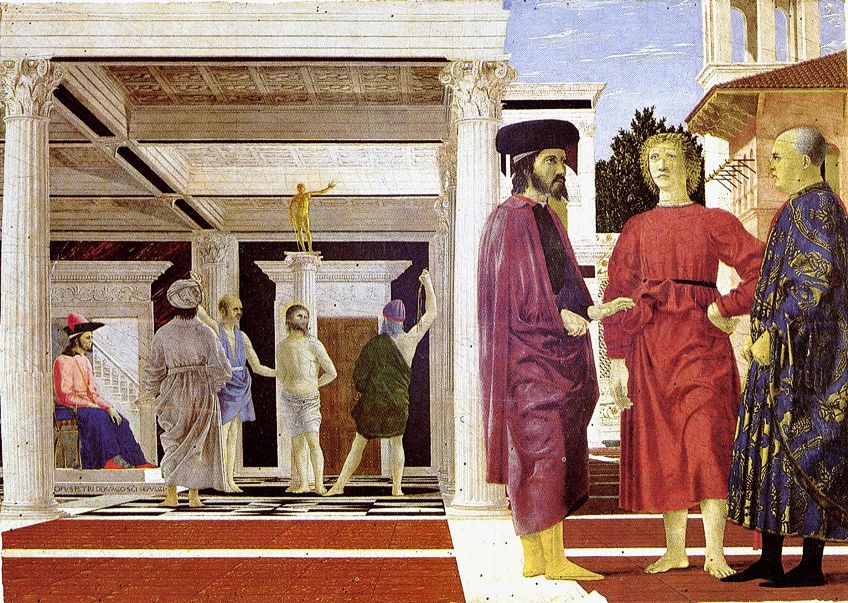 The Flagellation of Christ (1460) by Piero della Francesca, demonstrating many characteristics of Renaissance art, such equally linear perspective and the use of light and shadow;Piero della Francesca, Public domain, via Wikimedia Commons
The Flagellation of Christ (1460) by Piero della Francesca, demonstrating many characteristics of Renaissance art, such equally linear perspective and the use of light and shadow;Piero della Francesca, Public domain, via Wikimedia Commons
The departure from idealized religious iconography, made famous during the Medieval era and lasting until the start of the Renaissance allowed for new representations of heavenly subjects combined with a richer and more than human emotionality to emerge.
Renaissance artists developed and perfected a variety of techniques that allowed them to create extreme depth, accuracy, and correctly proportioned figures inside their paintings and sculptures. This elevated the artworks fabricated, equally more than authentic and genuine scenes were provided for viewers.
The 15 Most Famous Renaissance Paintings to Exist
As the well-nigh iconic art movement to ever exist, the Renaissance gave nascence to many notable paintings which have found their way into the current pop culture of today. Despite numerous artists helping to shape the evolution of the Renaissance, only a select few are particularly praised and remembered for their contribution.
While the post-obit list may not be very exhaustive, we volition be taking a look at the near respected and celebrated paintings to sally from the Renaissance.
The Kiss of Judas (1306) by Giotto
| Artist | Giotto |
| Appointment Painted | 1306 |
| Medium | Fresco |
| Dimensions | 200 cm x 185 cm |
| Where Information technology Is Currently Housed | Scrovegni (Arena) Chapel, Padua, Italian republic |
Painted by Italian painter and architect Giotto di Bondone in 1306, The Buss of Judas has provided inspiration for countless artists that have come later on its initial cosmos. Depicting the moment that the expose of Jesus by Judas occurred, this artwork has also ordinarily been referred to every bit the "Betrayal of Christ." According to the Bible, this deception by Judas was said to occur shortly subsequently the Terminal Supper, as he went on to identify Christ through a kiss before notifying the surrounding Roman soldiers.
In one case Jesus was identified, he was arrested and after executed. The Kiss of Judas represented an integral moment within Christianity, with this event going on to coin the phrase of a "Judas Kiss". Taking place in the Garden of Gethsemane, Giotto painted an evening scene that farther emphasized the drama in the painting.
By placing endless figures in the background of the limerick, he created the perception of an overpowering sense of certainty effectually Christ'south impending death.
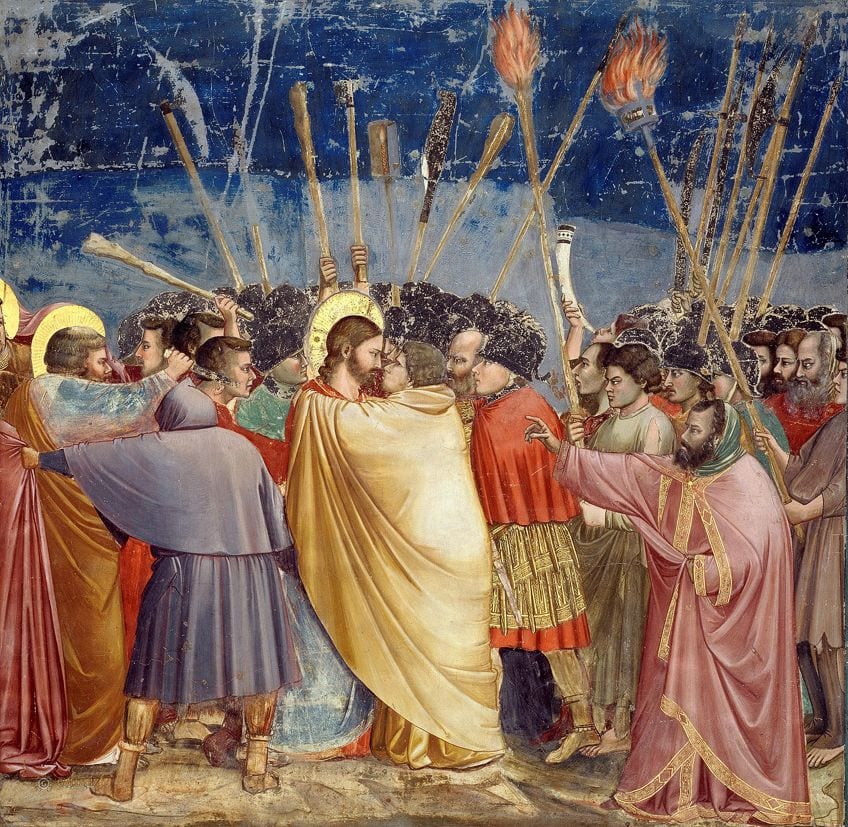 No. 31 of Scenes from the Life of Christ: xv. The Arrest of Christ (Kiss of Judas) (1304-1306) by Giotto di Bondone. Scrovegni Chapel, Padua, Italy;Giotto di Bondone, Public domain, via Wikimedia Commons
No. 31 of Scenes from the Life of Christ: xv. The Arrest of Christ (Kiss of Judas) (1304-1306) by Giotto di Bondone. Scrovegni Chapel, Padua, Italy;Giotto di Bondone, Public domain, via Wikimedia Commons
Painted in the Scrovegni Chapel in Italy equally part of a fresco cycle, Giotto was able to draw a truly confrontational and highly emotional scene. The Buss of Judas proved to be the most popular and highly sought-after fresco from the grouping of paintings Giotto produced, which led many critics to state that no other artist could possibly surpass the quality of his works. Giotto'due south skill as a painter became even more than evident within this artwork, every bit he was able to expertly capture the expression of both Judas and Jesus without the need for any words.
Some other reason as to why The Buss of Judas is such an iconic artwork is that it was believed to mark the end of the familiar and customary medieval style of painting. Its emergence onto the fine art scene was said to announce the new wave of the creative revolution that was known as the Early Renaissance. At the time of its cosmos, The Buss of Judas and the other fresco works within the group were considered to be the near modern works of art by any artist.
This painting truly set the standard for the new Renaissance move and its artists.
Annunciation (c. 1472 – 1475) past Leonardo da Vinci
| Creative person | Leonardo da Vinci |
| Date Painted | c. 1472 – 1475 |
| Medium | Oil and tempera on panel |
| Dimensions | 98 cm ten 217 cm |
| Where Information technology Is Currently Housed | Uffizi Gallery, Florence, Italy |
Possibly the greatest creative person to come from the Renaissance was Leonardo da Vinci, who was past all accounts considered to exist the quintessential "Renaissance Man". One of his notable works, painted around 1472 and 1475, was Announcement. Painted when he was simply 20 years of age, this artwork displayed sure characteristics and traits that were non even so seen equally "Leonardesque" when compared to his later works.
Inside this painting, da Vinci depicted an angel on the left side and the Virgin Mary on the correct, with a pulpit placed in betwixt them.
In a confined garden in the forepart of a Renaissance palace, Archangel Gabriel is kneeling before the Virgin and presenting her with a lily. Despite this action, the Virgin Mary remains seated in a dignified position behind the lectern, where she appears to exist reading. The affections, who is shown to be superbly youthful with his tall brow, elegant wings, and opulent clothing, is met by Mary's startled expression, which was farther emphasized by her raised hand. Her pose has also been described every bit potent, which emphasized her monumental nature.
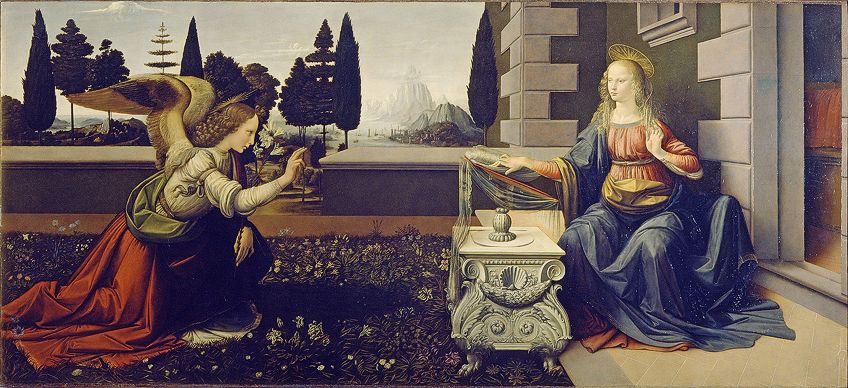 Announcement (c. 1472–1475), by Leonardo da Vinci, Uffizi Museum;Leonardo da Vinci, Public domain, via Wikimedia Eatables
Announcement (c. 1472–1475), by Leonardo da Vinci, Uffizi Museum;Leonardo da Vinci, Public domain, via Wikimedia Eatables
The composition of Annunciation followed an age-old model where an angel is placed on the left and the Virgin on the right, with a lectern separating them. The setting of this composition so customarily opens out onto a vast landscape, as seen in the background of this work. Da Vinci worked with this traditional and religious theme in a very earthy and natural style, as demonstrated by the angel. He is shown to accept true substantiality through his shadow that tin can be seen on the grass, as well equally through the realistic folds of his habiliment.
Considered to be a relatively immature work of da Vinci, very lilliputian is known regarding its initial location or who commissioned it.
An aspect that inevitably ties this work to da Vinci is the conventional use of dark colors that have been blended, which was a trademark in most of da Vinci's other works. Some anomalies can exist constitute within Declaration, such as the unusually long right arm of the Virgin. Even so, this has been attributed to da Vinci'southward immature historic period when creating this work, as he would yet continue to chief many techniques.
Lamentation of Christ (c. 1475 – 1501) by Andrea Mantegna
| Artist | Andrea Mantegna |
| Date Painted | c.1475 – 1501 |
| Medium | Tempera on canvass |
| Dimensions | 68 cm x 81 cm |
| Where It Is Currently Housed | Pinacoteca di Brera, Milan, Italian republic |
Painted by Italian artist Andrea Mantegna sometime betwixt 1475 and 1501, TheLamentation of Christ exists as a well-known painting to come from the Renaissance movement. Also known equally Lamentation over the Dead Christ or The Expressionless Christ, this artwork depicted the torso of Christ lying face upwards on a marble tabular array. To his left, he is being looked over by the Virgin Mary, Saint John, and St. Mary Magdalene, who are all grieving his death.
The theme of lamentation proved to exist a popular one during the Renaissance, yet Mantegna's treatment of Christ was quite unusual for the time period.
The bulk of other Lamentation paintings typically showed more than contact between the body of Christ and the mourners themselves, whereas the distance between these two subjects is emphasized within Mantegna's Lamentation of Christ. Despite this, Mantegna'southward painting presented a painful study of a foreshortened body in an extremely emotional representation of a biblical tragedy.
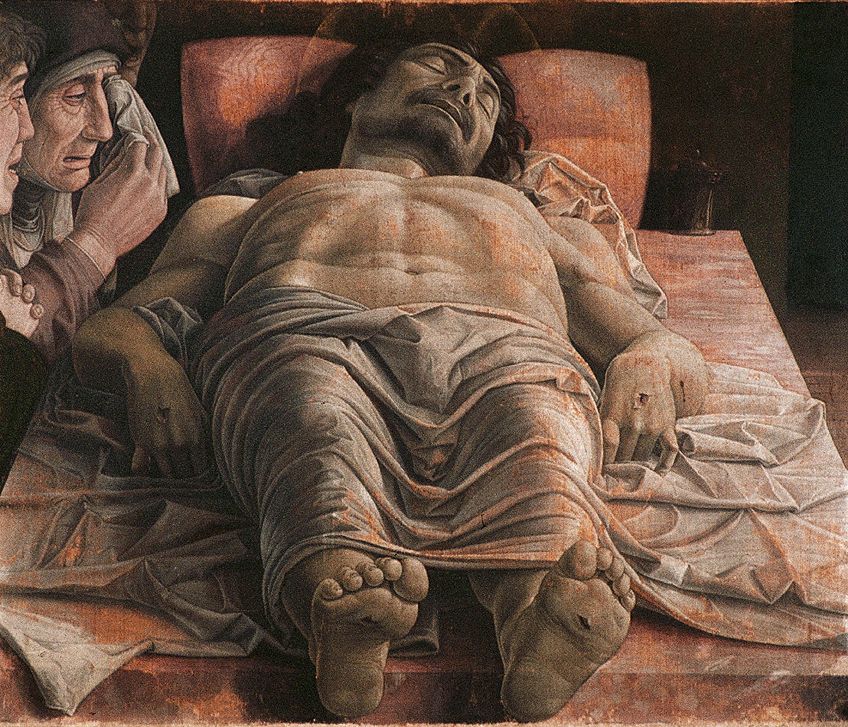 The Lamentation over the Dead Christ (1490) by Andrea Mantegna;Andrea Mantegna, Public domain, via Wikimedia Commons
The Lamentation over the Dead Christ (1490) by Andrea Mantegna;Andrea Mantegna, Public domain, via Wikimedia Commons
Both the realism and devastation of this scene were enhanced by Mantegna's forceful perspective, which he used to overstate and magnify the supine Christ. Additionally, he went on to emphasize some of Christ'south anatomical details, similar his thorax, also as depicting the holes in his hands and feet, and the crumpled faces of the mourners, in an incredibly harsh light.
This was washed in order to minimize any class of idealism, as Mantegna aimed to create an artwork that was able to fully capture the poignancy accompanying Christ'south death.
The lamentation of Christ was thought to be made for Mantegna'south own funerary chapel, as information technology was only found by his sons after he died. Still, the painting was soon sold off to settle his remaining debt, before finding its way to the Pinacoteca di Brera gallery in Milan. This artwork exists as one of the many examples of Mantegna's expertise in perspective, equally proven by the size of Christ's anxiety. While Christ's body was portrayed realistically, Mantegna was forced to skillfully reduce his feet and so that they would non dominate over the composition.
La Primavera (1477 – 1482) by Sandro Botticelli
| Artist | Sandro Botticelli |
| Date Painted | 1477 – 1482 |
| Medium | Tempera on panel |
| Dimensions | 202 cm x 314 cm |
| Where It Is Currently Housed | Uffizi Gallery, Florence, Italy |
Notable Italian painter Sandro Botticelli created a handful of iconic Renaissance paintings during his career. La Primavera, painted betwixt 1477 and 1482, depicts an entirely mythological scene and is considered to be one of the about famous paintings in Western art. The artwork, whose title translates to "spring" in Italian, has too been referred to as "Allegory of Spring" throughout the years. Within this painting, Botticelli portrayed a series of figures found in classical mythology and placed them in what appeared to be woodland.
However, what made this painting so captivating was that Botticelli chose to present various mythologic figures in a specific arrangement purely for artful purposes.
Due to this, La Primavera did not follow an actual narrative, as no particular story became credible when viewing the piece of work. Both Botticelli's inspiration behind this work, too as his purpose for painting it, remains unknown today. La Primavera's mysteriousness has gone on to add to the peachy appeal associated with this artwork, every bit many different interpretations for information technology exist.
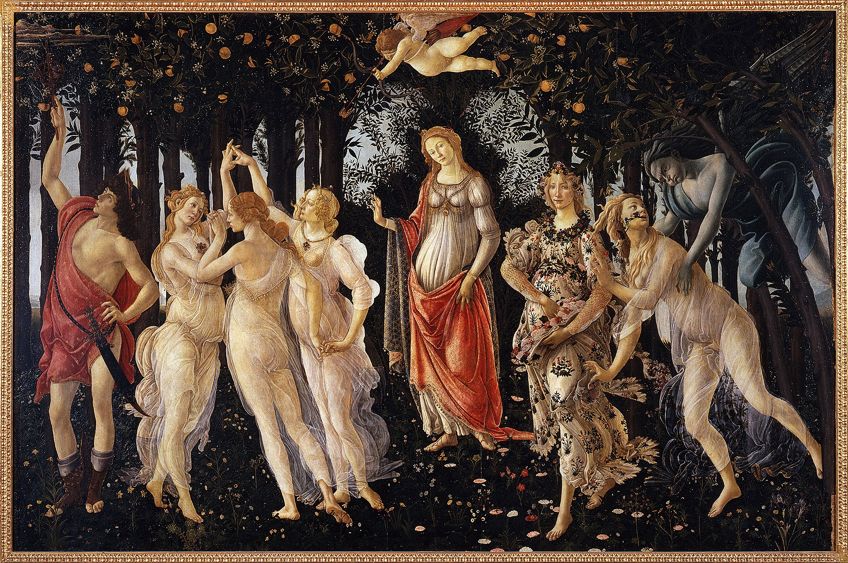 La Primavera (Spring)(c. 1480) by Sandro Botticelli;Sandro Botticelli, Public domain, via Wikimedia Eatables
La Primavera (Spring)(c. 1480) by Sandro Botticelli;Sandro Botticelli, Public domain, via Wikimedia Eatables
Seen equally a prime case of famous Renaissance fine art, La Primavera has generally been agreed to exist an allegory about the season of Spring, despite no bear witness bankroll this up. The central figure of Venus, the goddess of dearest and desire, tin be seen with the three graces dancing beside her on her left. Other goddesses are besides depicted, such as Chloris on the right, who is being followed past the figure of the West Wind before changing into the goddess Flora. Messenger god Mercury is besides depicted in the far left, while Cupid floats in a higher place Venus.
Despite some recognizable figures being represented in this painting, there has been much contend amongst fine art critics and scholars equally to its true meaning.
This has led Botticelli's piece of work to be seen every bit 1 of the almost written-about and controversial paintings to be, due to the variety of different explanations that can be attached to the scene. Additionally, LaPrimavera has been cited equally one of the earliest examples in Western post-classical painting to draw a not-religious scene which, in add-on to its hit color, was quite unusual at the time.
Adoration of the Magi (1481) by Leonardo da Vinci
| Artist | Leonardo da Vinci |
| Date Painted | 1481 |
| Medium | Oil on wood |
| Dimensions | 246 cm x 243 cm |
| Where It Is Currently Housed | Uffizi Gallery, Florence, Italia |
Another famous Renaissance art piece produced by Leonardo da Vinci was Adoration of the Magi, which he painted in 1481. Da Vinci was given the commission for this work past the Augustinian monks of San Donato in Scopeto, Florence, but concluded up leaving the painting unfinished when he moved to Milan a year after. Despite being incomplete, Adoration of the Magi is seen every bit a bang-up work of conceptual and formal intricacy.
Since 1670, the artwork has been housed in the Uffizi Gallery in Florence, where it can even so exist viewed today.
Da Vinci depicted the Virgin Mary and Child in the foreground of his composition. By placing the Magi, who was kneeling in admiration, to their right, he was able to form a type of triangular shape that was completed by the accompanying figures surrounding the two. Within the audience, some critics have said that da Vinci included a cocky-portrait of his younger self, as demonstrated by the figure on the far right. Other objects that can be seen included a ruin of a pagan edifice, which was in the process of being repaired.
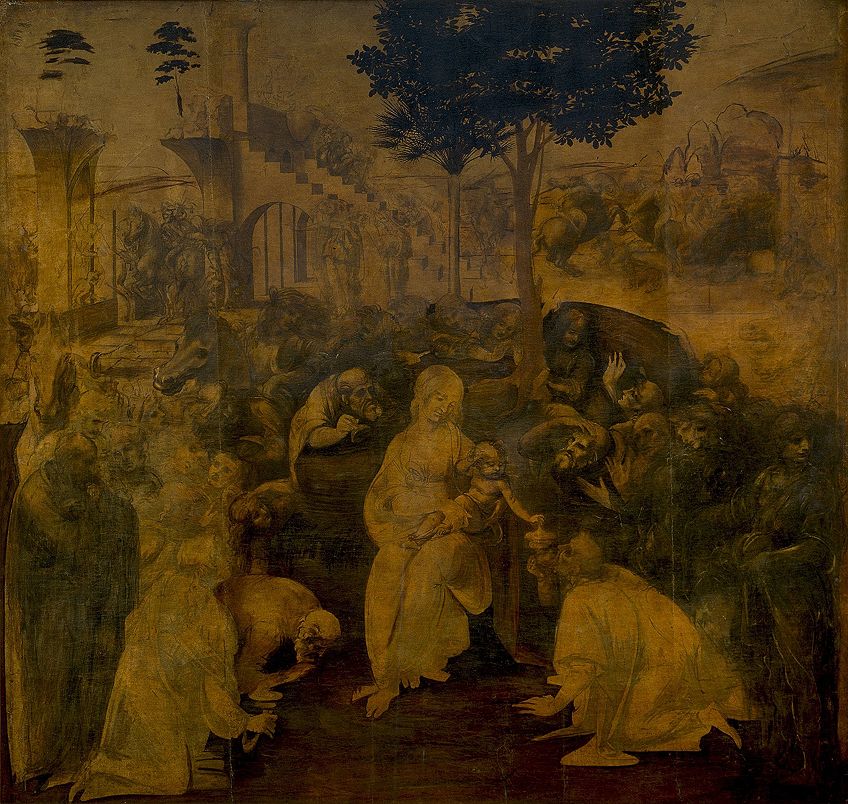 Leonardo da Vinci's unfinished Adoration of the Magi (1480-1482);Leonardo da Vinci, Public domain, via Wikimedia Commons
Leonardo da Vinci's unfinished Adoration of the Magi (1480-1482);Leonardo da Vinci, Public domain, via Wikimedia Commons
The building was thought to be a probable referral to the Basilica of Maxentius. As per an old Medieval legend, the Romans stated that the building would last until a virgin gave birth. Thus, the edifice supposedly collapsed on the nighttime that Christ was born. Despite the actual building not being in being until much later, da Vinci included a preparatory drawing of the ruins inside Adoration of the Magi. The large palm tree seen in the center of the work was said to exist another reference to the Virgin Mary, who saturday beneath information technology.
"Adoration of the Magi" is mayhap one of da Vinci's most peculiar yet innovative paintings.
By combining the audience members with the armed horsemen seen in the groundwork, da Vinci was able to transform an ordinary and mutual biblical field of study into a scene that could be taken from man history. Although this painting is thought to be remarkable for its farthermost ability, information technology was sent for some restoration work in 2011. Six years later, Adoration of the Magi emerged as a much cleaner and brighter artwork compared to what information technology was originally.
The Nascency of Venus (1485 – 1486) by Sandro Botticelli
| Artist | Sandro Botticelli |
| Appointment Painted | 1485 – 1486 |
| Medium | Tempera on canvas |
| Dimensions | 172.5 cm x 278.9 cm |
| Where It Is Currently Housed | Uffizi Gallery, Florence, Italian republic |
Perhaps one of the nigh famous Renaissance paintings to emerge from the motility was The Birth of Venus, which also went on to go the well-nigh significant painted created by Sandro Botticelli. Painted between 1485 and 1486, The Nascency of Venus was assumed to accept been commissioned by the Medici family for one of their sleeping room walls.
Much similar his other painting, "La Primavera", this Botticelli artwork was considered to exist revolutionary for portraying a not-religious scene from classical mythology on such a grand scale.
Within his limerick, Botticelli depicted the Roman goddess Venus rising out of the bounding main and arriving on the shore of Cyprus in a seashell. Fully-grown and completely naked, Venus is seen as a pure and mature woman who delicately placed her erotically charged hair over her body to emphasize her modesty and humility. As The Nativity of Venus was created in a time where nude subjects were condign common in paintings, Botticelli paid great attention to his representation of Venus, as he made sure to correctly render every particular.
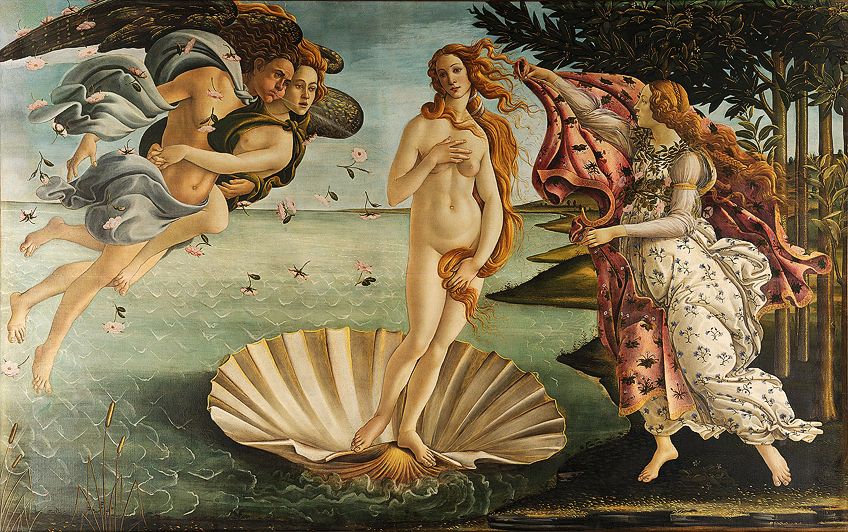 The Nativity of Venus (c. 1485) by Sandro Botticelli;Sandro Botticelli, Public domain, via Wikimedia Commons
The Nativity of Venus (c. 1485) by Sandro Botticelli;Sandro Botticelli, Public domain, via Wikimedia Commons
The near-life-sized Venus proved to be quite controversial, every bit nude subjects of this magnitude were almost unheard of in Western paintings at the time. Every bit the pose of Venus was said to celebrate classical Greco-Roman art, her stance was thus in reference to classical sculptures of the time. Withal, Botticelli appeared to accept exaggerated her figure to the signal where information technology became anatomically incommunicable, which added to the skepticism surrounding this work. Many interpretations of this painting take been proposed, with the near popular assay believing that Botticelli was representing the Neoplatonic idea of divine dearest through Venus. Afterwards his death, Botticelli's reputation began to falter, along with the prestige of The Nascency of Venus. Nevertheless, his importance was revived in the late 19th century, which saw this painting rising to international fame. As one of Botticelli'due south finest Renaissance artworks, this painting has since remained one of the most treasured paintings throughout history. Triptych art from the Renaissance remained a pop class of painting throughout the move, with one creative person in particular who managed to stand up out for his remarkable works. Dutch painter Hieronymus Bosch has been remembered for his stiff narrative panel paintings, with The Garden of Earthly Delights existing as his nigh famous piece. Painted somewhere betwixt 1490 and 1510, no verbal date for this great artwork actually exists. Non much is known about Bosch's groundbreaking masterpiece, except its sponsor being Engelbert II of Nassau of Brussels. As the most successful and outstanding of his artworks, The Garden of Earthly Delights was thought to be an altarpiece and was composed of three internal parts that were supposed to be read from left to correct. Each panel was incredibly essential to the overall meaning of Bosch's work, as they depicted the Garden of Eden flowing into Hell, as represented by the third panel. In the outset console, the true origin of The Garden of Earthly Delights can be seen through the depiction of God, Adam, and Eve in the bottom right. Nevertheless, the center panel proved to be the most pregnant when viewing the painting. Here, Bosch illustrated the growth of both the Garden of Eden and humanity, as the diverse figures tin can exist seen interacting in an ecstatic manner with one another. Surrounded by extraordinary creatures, animals, and fruits, this console was said to represent the moment before man was expelled from paradise. The self-captivated actions of the figures in the center were thought of as a teaser of what might follow, which was a depiction of the Last Judgement in the final console. Throughout history, this painting has been interpreted to be a didactic caveat on the dangers of life'south temptations, as well as mankind's life after its autumn from grace. Various interpretations of The Garden of Eden console accept uncovered its intricate symbolism, with many fine art historians remaining divided as to whether it exists as a true moral alarm or a scene of utopia lost. Yet another famous Renaissance art piece by Leonardo da Vinci is The Final Supper, which was painted between 1495 and 1498. Considered to be the best artwork produced by da Vinci, it was commissioned by the Knuckles of Milan for the refectory of the Convent of Santa Maria delle Grazie in Milan, where it tin still be viewed today. Like many other famous Renaissance paintings, The Last Supper is a religious scene that depicted the last supper of Jesus with his twelve apostles. Within The Final Supper, da Vinci showed off his masterful delineation of realism, as he was able to accurately portray cliffhanger and defoliation amongst those sitting at the tabular array when Jesus announced that one of them would beguile him. Every bit i of the globe's well-nigh recognizable paintings, Christ was depicted in the center and flanked by his disciples on both sides. However, da Vinci strayed from tradition in this work every bit he depicted Judas as separate from the group, choosing to convey his expose past placing him firmly hidden in shadow. Da Vinci'due south detailed knowledge of beefcake and light was accurately represented in this work, equally The Concluding Supper was noted for its clever use of these elements in addition to color. The triangular shape in the heart of the piece of work, with Jesus as the focal point, has been the subject of much debate over the years. Many fine art historians accept wondered about the possible significance of the "V" shape left between Jesus and the disciple on his right, thought to exist Mary Magdalene, but no concrete explanations exist. The long rectangular tabular array that the group sits backside acted every bit a boundary betwixt viewers and the occupants seen within this incredibly sacred moment. Past including walls on either side, da Vinci further emphasized the importance of the central scene by focusing the audition'due south attention on Jesus in the middle. Additionally, the use of linear perspective this manner added to the powerful and dramatic atmosphere of The Last Supper, which aided in it beingness seen as one of the about revered and famous artworks of all fourth dimension. During his career, Leonardo da Vinci was known to create many famous Renaissance paintings. However, his Mona Lisa, which he pained somewhere between 1503 and 1506, has long been classified equally the single most famous artwork ever fabricated in Western art. Existing equally half the top of a portrait, the subject in the painting was Lisa Gherardini, whose wealthy married man deputed this work of her. Today, the Mona Lisa is owned by the French and can exist viewed at the Louvre Museum in Paris where it attracts millions of viewers each yr. Praised equally the all-time-known and virtually visited painting in the world, the Mona Lisa is unarguably the virtually discussed painting ever, all because of her enigmatic and mysterious smile. Many debates have been had on the Mona Lisa'southward grinning, as much contention exists as to if she is fifty-fifty really grinning or not. The major feature of this painting is her eyes, equally da Vinci painted them in such a style that fifty-fifty when you motion abroad from the work or stand at another angle to view it, her eyes seem to always follow you lot around. The Mona Lisa is as well titled "la Gioconda", which translates to "happy" or "jovial" in Italian. Partly due to her elusive smile, da Vinci always saw this painting as a work in progress, as he continued to aim for perfection each time he worked on it. Many historians accept said that it is because of his quest for excellence that her smile turned out to be the near captivating attribute e'er seen inside a portrait. Due to the way da Vinci felt about the "Mona Lisa", he never delivered information technology to its commissioner and kept it with him until he died. Da Vinci'south composition of the Mona Lisa's figure was seen equally a radical transformation compared to the conventional portraits of women at the fourth dimension. Inside da Vinci'due south work, he purposefully left out any jewelry and decorative elements that could emphasize her social status so as to fully focus on her personality. Throughout history, the Mona Lisa has become so famous that it has been referenced and mimicked a myriad of times in other artworks and pop civilisation, almost notably within Marcel Duchamp's L.H.O.O.Q (1919). Another famous Renaissance art piece was The Schoolhouse of Athens , which was painted by Raphael between 1509 and 1511. This fresco, which is one of iv other frescos institute in the Churchly Palace in the Vatican, depicted all of the greatest scientists, philosophers, and mathematicians gathered together to share ideas and larn from i another. Regarded every bit Raphael's greatest masterpiece, this painting is said to symbolize philosophy equally the figures of Aristotle and Plato were seen in the center of the limerick. The three other frescoes making up the group are located on the 2nd floor of the Vatican Palace and are believed to symbolize branches of human being noesis in the course of poetry, theology, and law. From this group, The Schoolhouse of Athens has proven to be the virtually meaning and memorable fresco, as it thoroughly captured the classical spirit of the Renaissance. Raphael made great employ of perspective in his piece of work, as viewers' eyes are instantly drawn to the 2 principal figures standing in the eye, said to be Plato and Aristotle. The inclusion of Plato and Aristotle was and so that their unique ideas of philosophy were both represented. The group on the left of the composition represented Plato's theories, while the grouping on the right represented Aristotle's. The distinction was made betwixt these individuals by the cardinal figures in the piece of work, who stood on the side where their ideas were portrayed. Within The School of Athens, a full of 50 figures were included, which demonstrated Raphael'south keen mastery of realism painting. Raphael went so far as to include a moody portrait of himself in the scene, which revealed how highly he viewed himself equally an artist. Additionally, he was ostensibly aware of the grandeur of his painting, equally he had some suspicion that information technology would go on to permanently change the course of painting. Throughout fine art history, this painting has been labeled every bit the "perfect embodiment" of what the Renaissance stood for, as it accurately captured the classical spirit of the movement. When considering the most famous Renaissance paintings ever, The Creation of Adam is certain to come to mind. Painted by Michelangelo in 1512, this fresco adorns the ceiling of the Sistine Chapel in the Vatican and is seen as the cornerstone of Renaissance art. While Michelangelo painted multiple frescos on the ceiling, The Creation of Adam proved to be the most famous of the masterpiece. In addition to beingness an iconic epitome, information technology is also one of the earth's virtually reproduced images, proving to be very prevalent in today's popular civilization. The Creation of Adam has get a symbol of humanity, equally the painting depicts the easily of both God and Adam on the brink of touching. Adam is portrayed as a archetype muscular nude, reclining on the left of the work while he extends his hand out towards God, who fills upwards the rest of the composition. While Adam appears to be incredibly relaxed in his pose, God is shown to blitz towards him. God's haste is communicated through his white robes that flare behind him, which helped to emphasize the energetic motion of his body. Michelangelo portrayed angels surrounding God, while Adam appeared to be lying on the edge of the earth. Behind him, mountainous scenes are depicted through the green ledge upon which he lies. This groundwork created a strong diagonal between themselves, which emphasized the division that existed between Adam, a mere mortal, and the heavenly God. However, the truthful focal signal of this painting lies in the cardinal space between their easily, as the viewer'south eyes are immediately drawn to their extended still separated fingers. As the largest and nearly complicated fresco to ever be made, The Creation of Adam took Michelangelo over four years to stop. At the time of its creation, Pope Julius Two convinced the creative person to abandon the other job he was working on to focus on painting the now-iconic masterpiece. The Creation of Adam is now seen as an exquisite case of High Renaissance art, which enabled the Sistine Chapel ceiling to become the ultimate visual representation of the ideals and characteristics of the Renaissance. Another of the iconic Renaissance artist paintings produced by Raphael was The Sistine Madonna, which he painted between 1513 and 1514. Seen every bit Raphael's concluding great work of Renaissance art as he died a brusk while after its completion, The Sistine Madonna portrays Mary holding babe Jesus in her artillery. On either side of her, Saint Barbara and Saint Sixtus can be seen, with ii cherubs beneath her. Out of all the famous Renaissance artworks by Raphael, this painting has consistently been recognized as his most important work. Commissioned as an altarpiece for the church building of San Sisto in Piacenza, Italy, The Sistine Madonna depicts both Mary and the Christ child equally very concerned, while Saint Sixtus looked humbly towards her with his manus extended towards the heaven. Adding to the temper of dubiousness, the 2 saints seem to hover beneath Mary, as if they are unsure of where to go. However, the about iconic chemical element of this painting is the pair of impish cherubs seen at the bottom of the sail, who seem to exist incredibly bored with what is taking place. While one cherub looks above and rests his chin in his hand, the other looks to the side of the work, with his head resting on his crossed arms. Art critics have stated that it is their general sulky attitude that has further emphasized their presence and helped them stand up out in comparison to the rest of the piece of work. Additionally, their sullenness made them distinctly different from other typical rosy-cheeked and joyful cherubs found within other paintings, with Raphael thought to depict his cherubs this way in a supposed jab towards Michelangelo. As Raphael painted two of the almost iconic cherubs in art history, The Sistine Madonna caused quite a debate when information technology get-go arrived in Germany. Some questioned whether he blurred the lines between fine art and religion in this work. While information technology remains a truly iconic painting to come from the Renaissance, the two cherubs have gone on to achieve worldwide recognition. Their presence within popular culture has continued to grow throughout the years and has featured on numerous contemporary items. As the majority of the art from the Renaissance focused on religious imagery, the paintings produced by Titian proved to be no dissimilar. 1 of his famous Renaissance paintings includes Supposition of the Virgin, which he painted between 1516 and 1518. Painted as an altarpiece for the Basilica di Santa Maria Gloriosa dei Frari in Venice, Supposition of the Virgin has remained in its original location and tin can still be viewed there today. Titian divided the painting into three sections, which were all integral to the overall atmosphere of the work. Completed by Titian in the early on stages of his career, Assumption of the Virgin made use of incredibly vibrant colors. It was Titian's starting time commission in Venice, which went on to establish himself as a pb painter in the city. Depicting the "assumption of the virgin", which is celebrated every twelvemonth on August fifteenth, Titian immortalized the rising of Mary to heaven before her body began to decay. In the central section, Mary is existence raised by a group of angels towards sky, while her apostles say their goodbyes from the ground. In the top panel, God can be seen gazing down at Mary while she ascends towards him. Mary forms the focal point of the piece of work, as both God and the apostles focus their attending on her, which also helps straight the viewer's eyes towards her. God appears to be waiting patiently for Mary'due south arrival, while the apostles enhance their arms in amazement as they watch the true miracle unfolding right before them. Despite the piece being noticeably divided into three sections, they are each continued by extended hands and the repetition of facial expressions. Both the structured use of color and composition within Titian'due south work proved to be a key element in many Renaissance paintings, as works were frequently divided into thirds. After its creation, TheAssumption of the Virgin became the largest altarpiece in Venice and still is today. This painting demonstrated Titian's first attempt at trying to re-create the modern and dynamic scenes that were found in Raphael and Michelangelo's works, which were becoming more and more popular. Throughout the movement's existence, Renaissance creative person paintings produced past Titian proved to exist incredibly influential. Another one of his works, Venus of Urbino, which he painted in 1534, was inspired by Giorgione's Sleeping Venus (1510). Coming from a long tradition of various representations of Venus, Titian's artwork went a step further by interpreting the goddess in a much more erotic sense. Due to this, this painting stands out profoundly against other paintings near it in the Uffizi Gallery in Florence, where it is housed. Past depicting Venus in a domestic setting, every bit she is shown to be lounging on a bed, Titian gave the impression that she was a touchable, domesticated, and sensually explicit woman. This was all garnered through her relaxed pose, as she appeared to be utterly at ease despite being nude. Every bit this artwork held no straight religious implications, it was thought that Titian created information technology to be erotic on purpose. The sexuality in the work is heightened by Venus'due south straight gaze towards viewers, as her faint smile suggests that she is enlightened of those looking at her. While her nudity is juxtaposed against the opulent and lavish background, what makes this depiction of Venus so interesting is that it is devoid of any emblematic or mythological symbols that take customarily been associated with her presence. Instead, Titian placed all the emphasis on the realistic and tempting nature of Venus, as he contrasted the warm tones of her skin against the darker background so every bit to make her presence fifty-fifty more than distinct. His subtle utilise of chiaroscuro gave her body a sculptural quality that accentuated her curves. Various interpretations of this painting have been given throughout the years. The most common explanation is that information technology was deputed as a union portrait. Elements that supported this notion included the sleeping canis familiaris, the two servants, and the torso in the groundwork, which was typically given to the bride by her hubby's family. Venus of Urbino is considered i of the most famous and achieved examples of Renaissance fine art, as numerous other paintings have been inspired by and borrowed elements from this work. The final famous Renaissance art piece included on our list is The Last Sentence, which was painted by Michelangelo between 1536 and 1541. Located on the entire altar wall of the Sistine Chapel in the Vatican, The Last Sentence exists as one of the infamous frescoes painted by Michelangelo in the iconic chapel. Due to its gigantic size and sheer complication, every bit over 300 figures were included, this artwork took Michelangelo just over 5 years to complete. What makes The Concluding Sentence so notable was that Michelangelo began working on it 24 years later he completed the ceiling of the Sistine Chapel, meaning that he was in his sixties at the fourth dimension. He originally depicted all of the males equally nudes, but these were covered up at a later stage through the addition of draperies. Initially, the response that Michelangelo received afterwards completing his fresco was mixed between praise and criticism, as the muscular nudes became a major talking point as the about focus was placed on them. Inside The Last Judgement, the 2nd Coming of Christ is portrayed, which was the day when God was said to gauge all of humanity for the final time. By painting Christ in the middle, with his wounded easily and feet visible, and surrounding him with prominent saints, Michelangelo depicted a scene of troubling action. Christ'due south attention is firmly placed on the souls of the humans as they rose to their fates, as he looks down on the chaotic scene unfolding before him. The top department of the painting showed the resurrection of the dead to sky, while the bottom portion displayed the descent of sinners into hell. Certain elements of The Last Judgement have been scrutinized for centuries, such as Michelangelo's decision to represent Christ without a beard, which was very unusual for the fourth dimension. Michelangelo'south utilise of colour, equally well as his infrequent brushwork, have fabricated this painting i of the most revered artworks in the world, every bit information technology is considered to be the about influential fresco to sally from Western art. Art from the Renaissance proved to be extremely of import, every bit several works are still spoken about and admired today. Additionally, certain elements from famous Renaissance paintings have gone on to inspire and inform afterward art movements that emerged, which demonstrated the significance of the flow. While nosotros have simply discussed the 15 most famous Renaissance artworks, many more than great examples exist. If you take enjoyed reading up about these truly incredible paintings, we encourage y'all to explore further!
The Garden of Earthly Delights (c. 1490 – 1510) past Hieronymus Bosch
Creative person Hieronymus Bosch Date Painted c. 1490 – 1510 Medium Oil on oak panels Dimensions 205.5 cm x 384.9 cm Where It Is Currently Housed Museo del Prado, Madrid
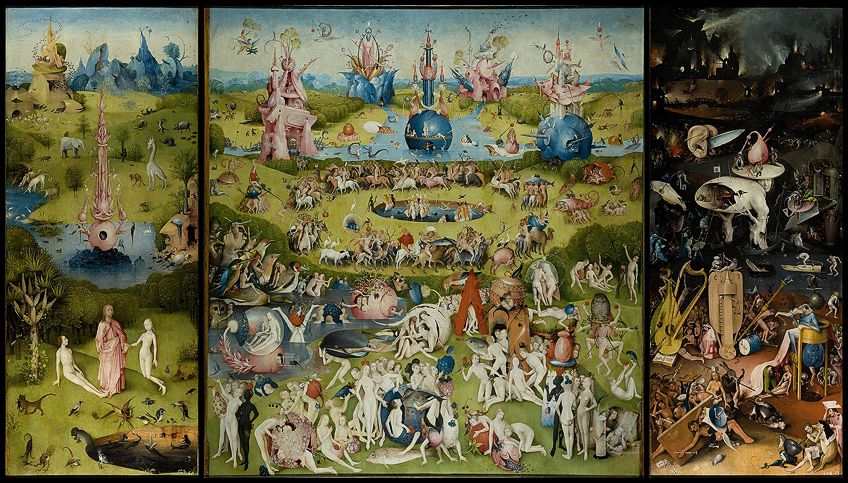 The Garden of Earthly Delights(between 1490 and 1500) by Hieronymus Bosch; Hieronymus Bosch, Public domain, via Wikimedia Eatables
The Garden of Earthly Delights(between 1490 and 1500) by Hieronymus Bosch; Hieronymus Bosch, Public domain, via Wikimedia Eatables
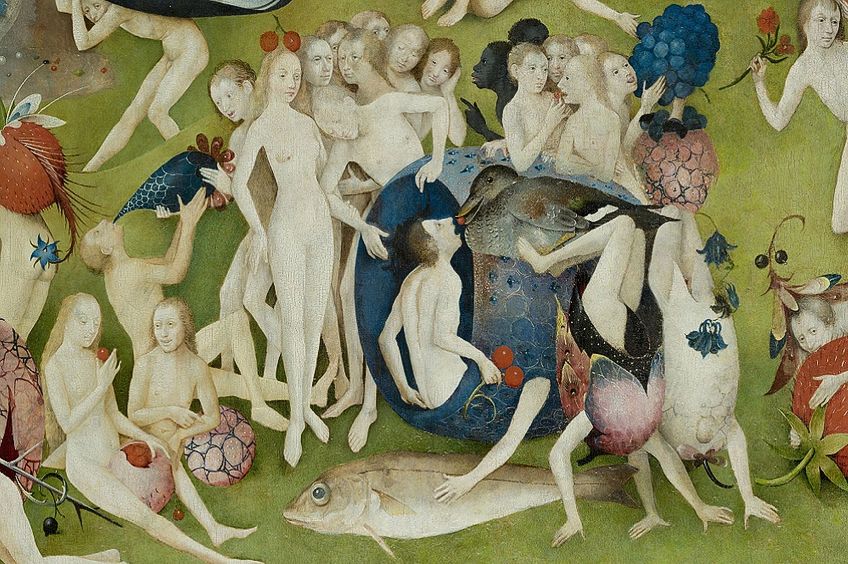 A detail of the central panel of The Garden of Earthly Delights (betwixt 1490 and 1500) by Hieronymus Bosch;Hieronymus Bosch, Public domain, via Wikimedia Commons
A detail of the central panel of The Garden of Earthly Delights (betwixt 1490 and 1500) by Hieronymus Bosch;Hieronymus Bosch, Public domain, via Wikimedia Commons The Last Supper (1495 – 1498) by Leonardo da Vinci
Creative person Leonardo da Vinci Date Painted 1495 – 1498 Medium Fresco Dimensions 700 cm 10 880 cm Where It Is Currently Housed Convent of Santa Maria delle Grazie, Italia
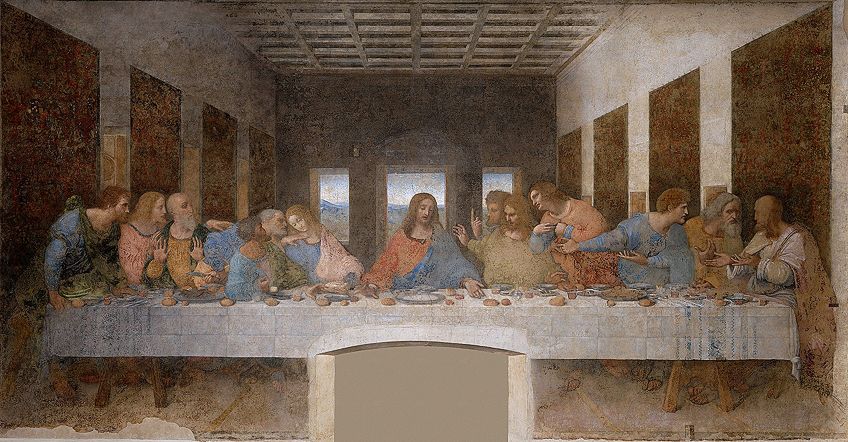 The Final Supper (1495-1498) by Leonardo da Vinci;Leonardo da Vinci, Public domain, via Wikimedia Commons
The Final Supper (1495-1498) by Leonardo da Vinci;Leonardo da Vinci, Public domain, via Wikimedia Commons
The Mona Lisa (c. 1503 – 1506) by Leonardo da Vinci
Artist Leonardo da Vinci Date Painted c. 1503 – 1506 Medium Oil on poplar panel Dimensions 77 cm x 53 cm Where Information technology Is Currently Housed The Louvre Museum, Paris, France
 Portrait of Mona Lisa del Giocondo (1503-1506) by Leonardo da Vinci; Leonardo da Vinci, Public domain, via Wikimedia Commons
Portrait of Mona Lisa del Giocondo (1503-1506) by Leonardo da Vinci; Leonardo da Vinci, Public domain, via Wikimedia Commons
The Schoolhouse of Athens (1509 – 1511) past Raphael
Artist Raphael Date Painted 1509 – 1511 Medium Fresco Dimensions 500 cm ten 770 cm Where Information technology Is Currently Housed Apostolic Palace, Vatican city
 The School of Athens (1509–1511) fresco by Raphael, at the Raphael Rooms, Apostolic Palace, Vatican City;Raphael, Public domain, via Wikimedia Eatables
The School of Athens (1509–1511) fresco by Raphael, at the Raphael Rooms, Apostolic Palace, Vatican City;Raphael, Public domain, via Wikimedia Eatables
The Creation of Adam (1512) by Michelangelo
Artist Michelangelo Date Painted 1512 Medium Fresco Dimensions 280 cm x 570 cm Where It Is Currently Housed Sistine Chapel, Vatican city
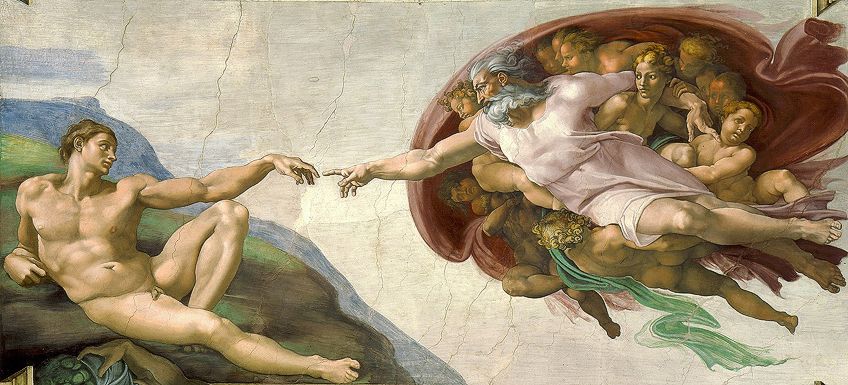 The Creation of Adam (1512) by Michelangelo, painted on the ceiling of the Sistine Chapel, Vatican City;Michelangelo, Public domain, via Wikimedia Commons
The Creation of Adam (1512) by Michelangelo, painted on the ceiling of the Sistine Chapel, Vatican City;Michelangelo, Public domain, via Wikimedia Commons
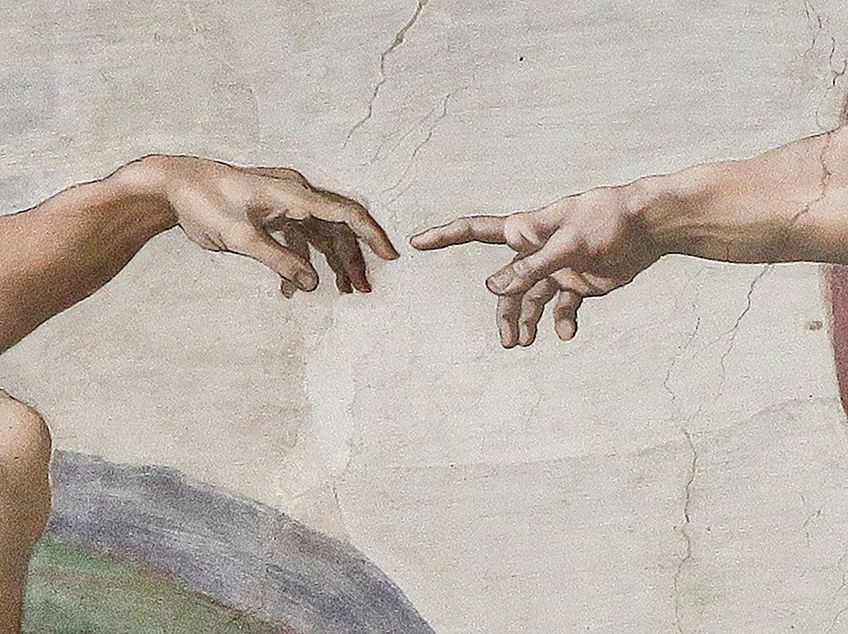 A detail of the hands from Michelangelo's The Creation of Adam, c. 1512;Michelangelo, Public domain, via Wikimedia Commons
A detail of the hands from Michelangelo's The Creation of Adam, c. 1512;Michelangelo, Public domain, via Wikimedia Commons The Sistine Madonna (1513 – 1514) past Raphael
Creative person Raphael Date Painted 1513 – 1514 Medium Oil on sheet Dimensions 265 cm x 196 cm Where It Is Currently Housed Gemäldegalerie Alte Meister, Germany
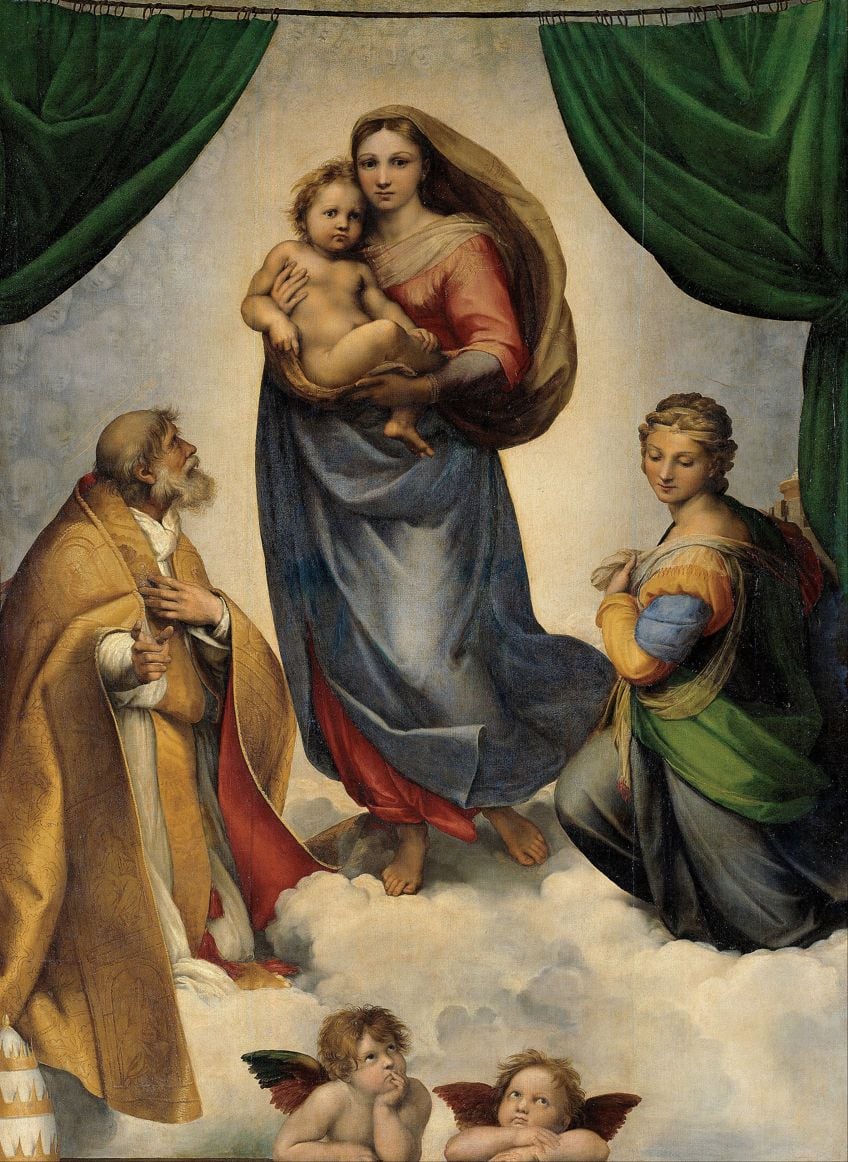 The Sistine Madonna(1512-1513) by Raphael;Raphael, Public domain, via Wikimedia Commons
The Sistine Madonna(1512-1513) by Raphael;Raphael, Public domain, via Wikimedia Commons
Assumption of the Virgin (1516 – 1518) past Titian
Artist Titian Date Painted 1516 – 1518 Medium Oil on panel Dimensions 690 cm x 360 cm Where It Is Currently Housed Basilica di Santa Maria Gloriosa dei Frari, Venice, Italian republic
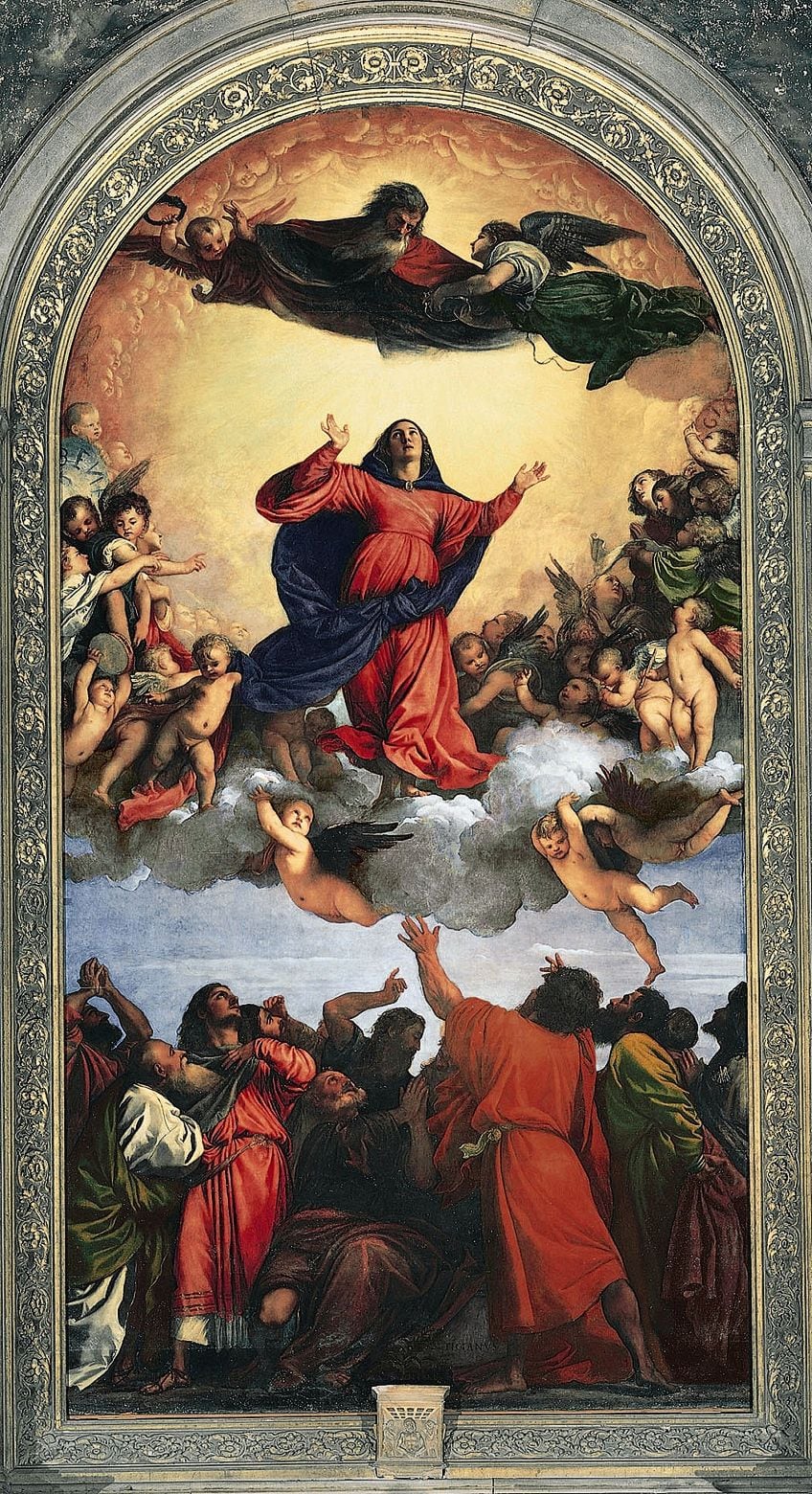 Supposition of Mary (1516-1518) by Titian; Titian, Public domain, via Wikimedia Eatables
Supposition of Mary (1516-1518) by Titian; Titian, Public domain, via Wikimedia Eatables
Venus of Urbino (1534) past Titian
Artist Titian Date Painted 1534 Medium Oil on canvas Dimensions 119 cm x 165 cm Where Information technology Is Currently Housed Uffizi Gallery, Florence, Italy
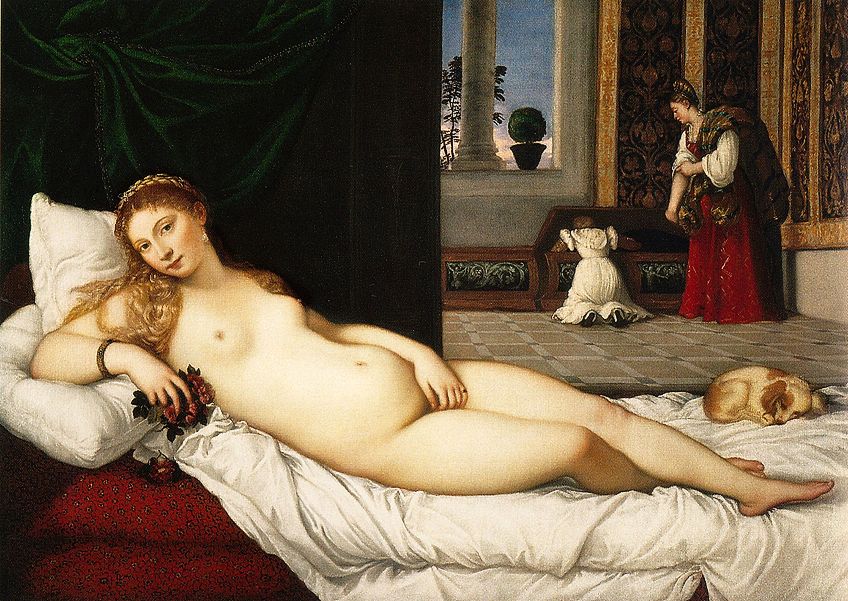 Venus of Urbino(c. 1538) by Titian;Titian, Public domain, via Wikimedia Eatables
Venus of Urbino(c. 1538) by Titian;Titian, Public domain, via Wikimedia Eatables
The Terminal Judgement (1536 – 1541) by Michelangelo
Artist Michelangelo Date Painted 1536 – 1541 Medium Fresco Dimensions thirteen.7 m x 12 1000 Where It Is Currently Housed Sistine Chapel, The holy see
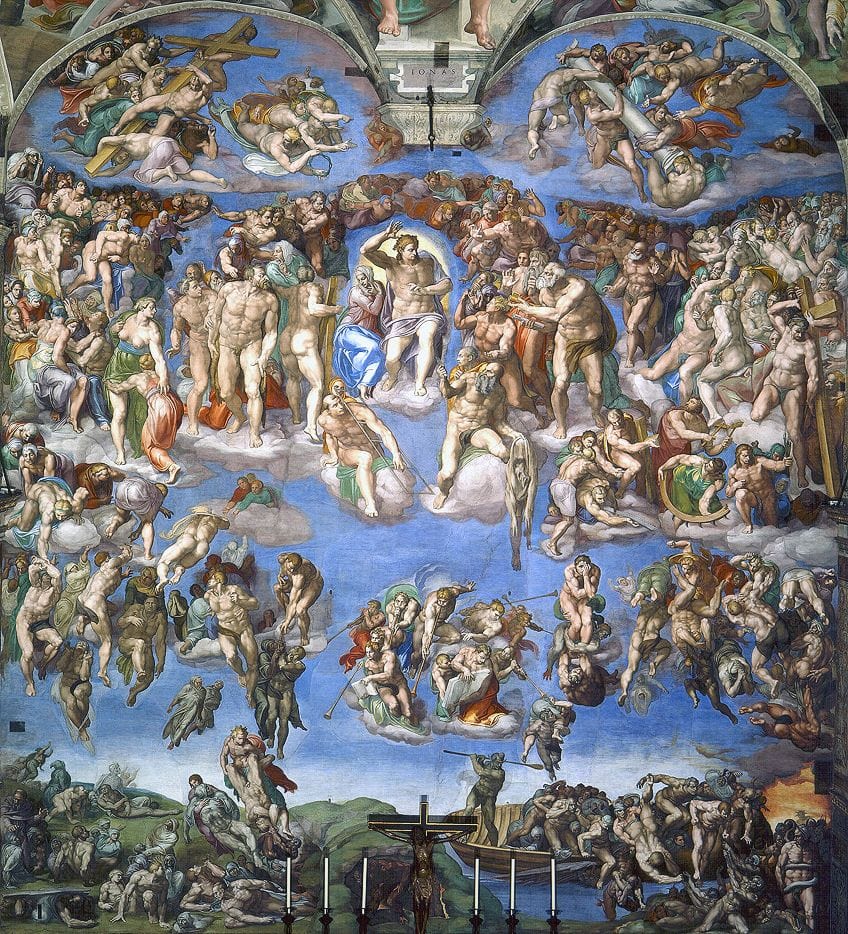 The Last Judgment (1536-1541) past Michelangelo, painted on the ceiling of the Sistine Chapel;Michelangelo, Public domain, via Wikimedia Commons
The Last Judgment (1536-1541) past Michelangelo, painted on the ceiling of the Sistine Chapel;Michelangelo, Public domain, via Wikimedia Commons
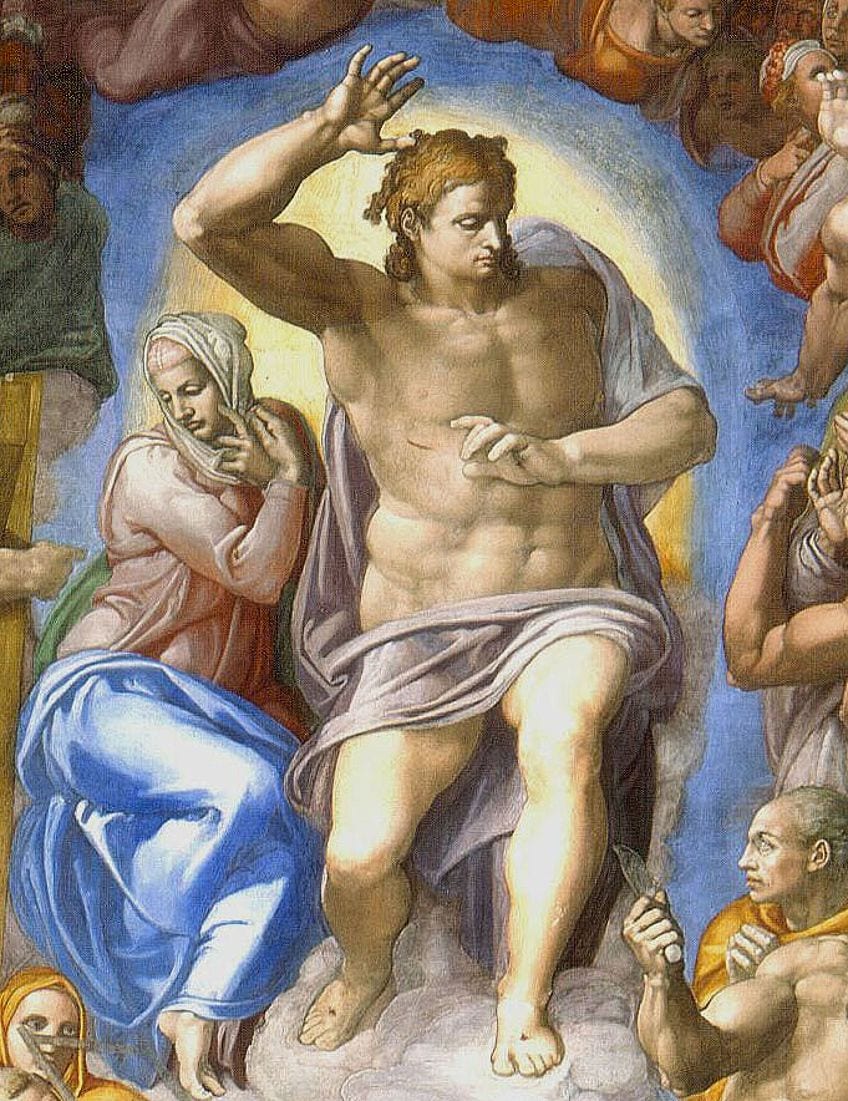 Particular from The Last Judgement by Michelangelo, 1534-1541;Michelangelo, Public domain, via Wikimedia Commons
Particular from The Last Judgement by Michelangelo, 1534-1541;Michelangelo, Public domain, via Wikimedia Commons
Source: https://artincontext.org/famous-renaissance-paintings/
0 Response to "How Is the Birth of Venus a Good Representation of Renaissance Art"
Post a Comment